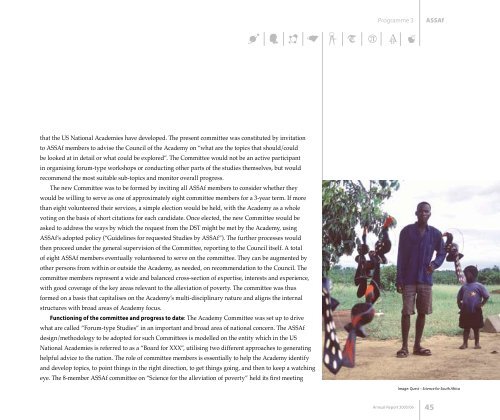Academy of Science South Africa 2005/6 Annual Report
Academy of Science South Africa 2005/6 Annual Report
Academy of Science South Africa 2005/6 Annual Report
- No tags were found...
You also want an ePaper? Increase the reach of your titles
YUMPU automatically turns print PDFs into web optimized ePapers that Google loves.
Programme 3ASSAfthat the US National Academies have developed. The present committee was constituted by invitationto ASSAf members to advise the Council <strong>of</strong> the <strong>Academy</strong> on “what are the topics that should/couldbe looked at in detail or what could be explored”. The Committee would not be an active participantin organising forum-type workshops or conducting other parts <strong>of</strong> the studies themselves, but wouldrecommend the most suitable sub-topics and monitor overall progress.The new Committee was to be formed by inviting all ASSAf members to consider whether theywould be willing to serve as one <strong>of</strong> approximately eight committee members for a 3-year term. If morethan eight volunteered their services, a simple election would be held, with the <strong>Academy</strong> as a wholevoting on the basis <strong>of</strong> short citations for each candidate. Once elected, the new Committee would beasked to address the ways by which the request from the DST might be met by the <strong>Academy</strong>, usingASSAf’s adopted policy (“Guidelines for requested Studies by ASSAf”). The further processes wouldthen proceed under the general supervision <strong>of</strong> the Committee, reporting to the Council itself. A total<strong>of</strong> eight ASSAf members eventually volunteered to serve on the committee. They can be augmented byother persons from within or outside the <strong>Academy</strong>, as needed, on recommendation to the Council. Thecommittee members represent a wide and balanced cross-section <strong>of</strong> expertise, interests and experience,with good coverage <strong>of</strong> the key areas relevant to the alleviation <strong>of</strong> poverty. The committee was thusformed on a basis that capitalises on the <strong>Academy</strong>’s multi-disciplinary nature and aligns the internalstructures with broad areas <strong>of</strong> <strong>Academy</strong> focus.Functioning <strong>of</strong> the committee and progress to date: The <strong>Academy</strong> Committee was set up to drivewhat are called “Forum-type Studies” in an important and broad area <strong>of</strong> national concern. The ASSAfdesign/methodology to be adopted for such Committees is modelled on the entity which in the USNational Academies is referred to as a “Board for XXX”, utilising two different approaches to generatinghelpful advice to the nation. The role <strong>of</strong> committee members is essentially to help the <strong>Academy</strong> identifyand develop topics, to point things in the right direction, to get things going, and then to keep a watchingeye. The 8-member ASSAf committee on “<strong>Science</strong> for the alleviation <strong>of</strong> poverty” held its first meetingImage: Quest – <strong>Science</strong> for <strong>South</strong> <strong>Africa</strong><strong>Annual</strong> <strong>Report</strong> <strong>2005</strong>/0645









![National Research Foundation Annual Report 2008 / 2009 [Part 2]](https://img.yumpu.com/49774036/1/177x260/national-research-foundation-annual-report-2008-2009-part-2.jpg?quality=85)






